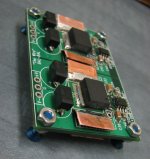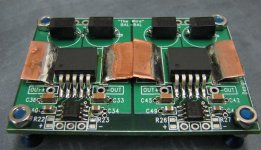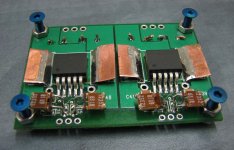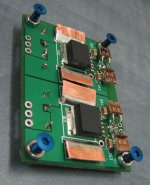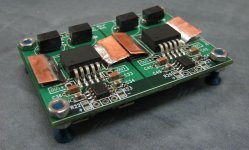Right, the time has come to give this a proper venue, so that build queries, impressions and casework ideas can be shared and searched more adequately. The SNR in the OG thread has gotten out of control.
My amp is pretty non-standard, so not really something people will follow, but it might give some ideas.
So fire away guys, people should feel free to start posting pics, impressions and questions related to their own builds. I will try to help out here as time allows, but hopefully supporting this will be a community effort that isnt limited to opc and myself. I encourage you to all get involved, for an amp that has so many pcbs out there there doesnt seem to be all that many finished projects; whats up with that?
Anyway; On with the show! such a great little amp, looking forward to hearing some more impressions
so heres my BAL-BAL, optimized for low profile and low impedance for battery operation. the TX2352 Zfoils are just till the ASMP SMD zfoils arrive, i have omitted the input resistors and will bridge them to keep the input lowZ, as this is also the IV stage for my portable sabre
I had to improvise with the heatsinks, i wont need all that much for this build and the BOM sinks are too large, so these are made with Goertz 8awg copper foil speaker cable bent into shape; the PCB alone might have been enough at the lower voltage i'm using and unity gain, but given the rather low impedance headphones I Favor, I thought it best to add some backup, plus it looks pretty sweet.
The panasonic SP polymer caps are used for low profile, never mind they are the lowest impedance caps i know of, but after the issues a couple of people had with the soldermask shorting through, I thought it best to elevate them a little bit on some 18awg copper 'leads'; they are still shorter than any lowz can type PTH cap i know of, so worked out well
the 2 middle heatsinks are not as close as they appear
ok since its been asked again....
NO! there are no PCBs left!
My amp is pretty non-standard, so not really something people will follow, but it might give some ideas.
So fire away guys, people should feel free to start posting pics, impressions and questions related to their own builds. I will try to help out here as time allows, but hopefully supporting this will be a community effort that isnt limited to opc and myself. I encourage you to all get involved, for an amp that has so many pcbs out there there doesnt seem to be all that many finished projects; whats up with that?
Anyway; On with the show! such a great little amp, looking forward to hearing some more impressions
so heres my BAL-BAL, optimized for low profile and low impedance for battery operation. the TX2352 Zfoils are just till the ASMP SMD zfoils arrive, i have omitted the input resistors and will bridge them to keep the input lowZ, as this is also the IV stage for my portable sabre
I had to improvise with the heatsinks, i wont need all that much for this build and the BOM sinks are too large, so these are made with Goertz 8awg copper foil speaker cable bent into shape; the PCB alone might have been enough at the lower voltage i'm using and unity gain, but given the rather low impedance headphones I Favor, I thought it best to add some backup, plus it looks pretty sweet.
The panasonic SP polymer caps are used for low profile, never mind they are the lowest impedance caps i know of, but after the issues a couple of people had with the soldermask shorting through, I thought it best to elevate them a little bit on some 18awg copper 'leads'; they are still shorter than any lowz can type PTH cap i know of, so worked out well
the 2 middle heatsinks are not as close as they appear
ok since its been asked again....
NO! there are no PCBs left!
Attachments
Last edited:
Anyway; On with the show! such a great little amp, looking forward to hearing some more impressions
Great initiative to have a separate thread for building!
It might be handy to have some links early in the thread, especially to the build wiki - "The Wire" Headphone Amp Build Wiki - diyAudio
I am looking forward to having parts soon to start building my own, till then I'll keep peaking in here for photos
Very nice! I love the low profile. How thin did you manage when it's all said and done? I'm guessing 0.5" but you might be able to do even better than that.
It does look like you've got a cold solder joint on the left side of C45 however. Might need to get the iron back out to touch that one up
What rail voltage will you get off the batteries? Anything below 10V should make for very minimal disspation, so heat shouldn't be an issue.
The BAL-BAL is my main headamp right now, and I'm driving it off the output of an AD1955 reference board into my AH-D2000's. I really like this setup, and I love how the BAL-BAL performs with the Denons. I'm looking forward to listening impression when you get your batteries all wire up and ready to go!
Cheers,
Owen
It does look like you've got a cold solder joint on the left side of C45 however. Might need to get the iron back out to touch that one up
What rail voltage will you get off the batteries? Anything below 10V should make for very minimal disspation, so heat shouldn't be an issue.
The BAL-BAL is my main headamp right now, and I'm driving it off the output of an AD1955 reference board into my AH-D2000's. I really like this setup, and I love how the BAL-BAL performs with the Denons. I'm looking forward to listening impression when you get your batteries all wire up and ready to go!
Cheers,
Owen
Last edited:
hehe i thought you might say something about that, but its actually fine, theres just a bit of black scum from the cardas flux in the middle, but now youve said something i wont be able to help it =D. edit: actually I just looked at the real thing and its a convex spot in the shiny mirror like reflection causing a black spot in the photo =D see below for better angle
as for the profile, nothing extends higher than the buffer top or bottom (~10mm thick all up), cant get any smaller than that unless I start lapping away at the epoxy down to the die the screw standoffs are just temporary while i work with it on the bench
the screw standoffs are just temporary while i work with it on the bench
the voltage is lower than that, about +/-6.8-7.2vdc but all the current it can eat as i'm feeding this direct from the batteries; which are capable of 70A constant and 120A burst and have an output impedance of about 25mOhms. I'm thinking of trying the front end off the dual mono bipolar LDOs and only feeding the buffers direct from 600uf per rail of SP caps about 40mm away in the case, but whether this will be an improvement is dubious, it would just mean that it would be shutdown automatically with low battery like the rest of the unit.
voltage is a bit low for the buffers, but to get decent runtime of about 7hrs with the rest of the dac and PSU eating about 325ma, i couldnt fit more M1A cells into a usable chassis. going from previous impressions if this is better than it was already, its like nothing available commercially portable thats for sure (even the ibasso DX100 does not perform at this level, theyve the analogue stage must be limiting performance to get the performance they are getting with 9018 IMO. I expect the runtime to reduce down to about 5hrs with the added buffers, i'm pretty excited myself!!
as for the profile, nothing extends higher than the buffer top or bottom (~10mm thick all up), cant get any smaller than that unless I start lapping away at the epoxy down to the die
the voltage is lower than that, about +/-6.8-7.2vdc but all the current it can eat as i'm feeding this direct from the batteries; which are capable of 70A constant and 120A burst and have an output impedance of about 25mOhms. I'm thinking of trying the front end off the dual mono bipolar LDOs and only feeding the buffers direct from 600uf per rail of SP caps about 40mm away in the case, but whether this will be an improvement is dubious, it would just mean that it would be shutdown automatically with low battery like the rest of the unit.
voltage is a bit low for the buffers, but to get decent runtime of about 7hrs with the rest of the dac and PSU eating about 325ma, i couldnt fit more M1A cells into a usable chassis. going from previous impressions if this is better than it was already, its like nothing available commercially portable thats for sure (even the ibasso DX100 does not perform at this level, theyve the analogue stage must be limiting performance to get the performance they are getting with 9018 IMO. I expect the runtime to reduce down to about 5hrs with the added buffers, i'm pretty excited myself!!
Attachments
Last edited:
as this is also the IV stage for my portable sabre
Do you have some info about this portable sabre project? I'm interested
Do you have some info about this portable sabre project? I'm interested
nah its 100% DIY and i never planned for it to go on sale so its not documented and i dont plan to, also perhaps you would do a double take if you saw the cost to complete a unit. i'll have more pics of it in the next couple of days, just uses a modified buffalo II, a PSU/MCU of my design, but laid out by Nattonrice, transformer coupled spdif and the bal-bal wire. all parts are OTT and once the chassis is finished it will have cost around 1500-1750 minimum. its more transportable than portable, but comfortably fits in my manbag or coat
I haven't finished anything because I'm trying to sort/plan out everything and I'm also trying to pick up arduino so I can configure a 7-segment lcd display for the relay attenuator that I'm planning to use. What's everyone using for a case?
I can't believe qusp let you say the words 'relay attenuator'. Is there no other vol control you could use? What devices are upstream of your wire? If you're already using an arduino it would be more compact and perhaps better solution to use digital volume control?
Apologies, I feel the need to venture slightly off topic:
nah its 100% DIY and i never planned for it to go on sale so its not documented and i dont plan to, also perhaps you would do a double take if you saw the cost to complete a unit. i'll have more pics of it in the next couple of days, just uses a modified buffalo II, a PSU/MCU of my design, but laid out by Nattonrice, transformer coupled spdif and the bal-bal wire. all parts are OTT and once the chassis is finished it will have cost around 1500-1750 minimum. its more transportable than portable, but comfortably fits in my manbag or coat
I can't help myself - What is this spdif thing you mention? Did you go to an antique store? When you mentioned that project previously I'd erroneously assumed you were feeding it from an iPad via usb. I suppose UAC2 devices of OTT nature don't really lend themselves to portable/transportable implementations at the moment.
qn Research Labs Pty Ltd must be some sort of privately funded research lab that only work on classified projects.
Last edited:
hehe indeed, thx mate! thx even for the wrinkles lol LED indication circuit was completely your idea, happy to give credit where credit is due =PYay go me
nah i will leave an i2s input, but theres no USB, the ipad usb audio implementation is a hack and performs as such, but if a suitable UAC2 solution comes along for portable i'll use that via i2s or spin another pcb. as it is theres nothing suitable, even if there was something able to be made small enough, the current needed to run them is too much for portable.I can't help myself - What is this spdif thing you mention? Did you go to an antique store? When you mentioned that project previously I'd erroneously assumed you were feeding it from an iPad via usb. I suppose UAC2 devices of OTT nature don't really lend themselves to portable/transportable implementations at the moment.
for now optical or mini bnc from my iriver is the transport, the river has a wired remote, so thats all i need to have access to rather than pulling out what may look like an IED in public transport or on a plane. runs on rockbox too. the sabre spdif implementation is actually pretty good and the input board i'm using uses a very nice scientific conversions transformer. optical is very handy for portable due to the isolation from grounds and if another more modern device is released with digital out its likely to be optical; by that i mean one that is able to be used as a digital transport, perhaps with touchscreen, but without having to buy something that includes an inferior dac and headphone amp to get it.
my plan eventually is to spin an SD card reader PCB,m perhaps based on 'the ultimate source' and connect by LVDS
yep, if we told you what we are doing we'de have to kill youqn Research Labs Pty Ltd must be some sort of privately funded research lab that only work on classified projects.
Last edited:
I can't believe qusp let you say the words 'relay attenuator'. Is there no other vol control you could use? What devices are upstream of your wire? If you're already using an arduino it would be more compact and perhaps better solution to use digital volume control?
Woah, why so much hate for a relay based attenuator? It's definitely better matched than most standard pots. It's also fairly simple to short out to completely bypass the entire volume control and use a digital volume control upstream. Of course, it could always be worse, I could be saying that I'm using a LDR attenuator
qusp: I hope you post plenty of pictures when it's complete
Relay attenuators (R-2R ladder) have tons of advantages when well implemented using latching relays. Aside the relay switching noise which I can understand is quite ennoying when changing volume, I don't see the hate for them...
Beside, I've also been using digital volume control on my dual mono BII and as much as I want to like it, there's something about it I don't like... ah yeah... I have multiple sources on my preamp and can manage different volume for each one of them. BII volumite, well, just BII volumite...
The other option would be to use PGA2310 or 2311 but then it is not on par with R-2R... The other option would be to use mosfets as switches instead of relays. That is pretty quiet and works pretty good...
Anyway, volume in digital domain is quite good but I guess to everyone is own taste!
Ciao!
Do
Beside, I've also been using digital volume control on my dual mono BII and as much as I want to like it, there's something about it I don't like... ah yeah... I have multiple sources on my preamp and can manage different volume for each one of them. BII volumite, well, just BII volumite...
The other option would be to use PGA2310 or 2311 but then it is not on par with R-2R... The other option would be to use mosfets as switches instead of relays. That is pretty quiet and works pretty good...
Anyway, volume in digital domain is quite good but I guess to everyone is own taste!
Ciao!
Do
I would tend to agree with the above. I love my BII digital domain volume control, but before that I used a relay based shunt volume control and it was by far my favorite volume control setup, and offered much more flexibility than the digital volume control does.
I prefer the taper and the sound of the digital attenuator, but not by a very large margin.
My personal pecking order is:
1. Proper digital attenuator (a la ESS DAC style, NOT windows volume control!)
2. Shunt relay attenuator
3. Shunt stepped attenuator
4. Ladder stepped attenuator
5. Standard stepped attenuator
6. PGA
7. Dual gang resistive element pot
8. Full volume while wearing earplugs
9. SSRs or mosfet based relay style attenuators
- I've never heard a lightspeed, so I can't comment.
Has anyone here ever measured a mosfet or SSR? I promise you, it's not pretty. They're significantly worse than a standard relay, and it's actually quite audible at low volume levels. I personally avoid them like the plague.
Just my 2 cents.
Cheers,
Owen
P.S. the ladies love the sound of my clicking relay shunt attenuator...
I prefer the taper and the sound of the digital attenuator, but not by a very large margin.
My personal pecking order is:
1. Proper digital attenuator (a la ESS DAC style, NOT windows volume control!)
2. Shunt relay attenuator
3. Shunt stepped attenuator
4. Ladder stepped attenuator
5. Standard stepped attenuator
6. PGA
7. Dual gang resistive element pot
8. Full volume while wearing earplugs
9. SSRs or mosfet based relay style attenuators
- I've never heard a lightspeed, so I can't comment.
Has anyone here ever measured a mosfet or SSR? I promise you, it's not pretty. They're significantly worse than a standard relay, and it's actually quite audible at low volume levels. I personally avoid them like the plague.
Just my 2 cents.
Cheers,
Owen
P.S. the ladies love the sound of my clicking relay shunt attenuator...
Last edited:
yeah i would tend to agree, shunt relay controls arent that bad, no hate here, but properly done high bit depth digital control on digital sources is just logical and completely transparent. pinnochio, if you dislike the sound of the volumite, you dislike the sound of your dac, provided you have set the gain on your amps so they are reasonably well suited to the load, the mechanism to set the volume is the same mechanism used to make a loud or soft sample, i dont know what the something could be, but i would suggest its in your head.
my top 3 are all digital
titan 64 bit floating point volume enacted in the DSP on the i2s stream
puremusic 64 bit floating point volume with noise shaping
Sabre 40 bit integrated volume
electronically controlled analogue attenuator
Shunt stepped attenuator
Relay shunt attenuator (but i cannot stand the click clack)
Standard Stepped (havent tried ladder)
quality resistive element pot
LDR
PGA (i dislike going to all this trouble with the signal and then putting everything through the integrated opamps)
my top 3 are all digital
titan 64 bit floating point volume enacted in the DSP on the i2s stream
puremusic 64 bit floating point volume with noise shaping
Sabre 40 bit integrated volume
electronically controlled analogue attenuator
Shunt stepped attenuator
Relay shunt attenuator (but i cannot stand the click clack)
Standard Stepped (havent tried ladder)
quality resistive element pot
LDR
PGA (i dislike going to all this trouble with the signal and then putting everything through the integrated opamps)
Last edited:
P.S. the ladies love the sound of my clicking relay shunt attenuator...
By all means, please share with us the details of said attenuator.
Any thing that serves such noble dual purpose is far and above, a most sought after choice for me!
My avoidance of relays was based on the misconception that people don't often have more than one source for a headphone rig, which makes it simpler to use dig volume control. I've not done any comparison between the different methods. I differ to qusp and opc's experiences as they've got miles more experience with these than I do.
opc, what do they say about the appearance of your tiny lpuhp amps if they love the sound of clicking shunt attenuators
opc, what do they say about the appearance of your tiny lpuhp amps if they love the sound of clicking shunt attenuators
yeah i would tend to agree, shunt relay controls arent that bad, no hate here, but properly done high bit depth digital control on digital sources is just logical and completely transparent. pinnochio, if you dislike the sound of the volumite, you dislike the sound of your dac, provided you have set the gain on your amps so they are reasonably well suited to the load, the mechanism to set the volume is the same mechanism used to make a loud or soft sample, i dont know what the something could be, but i would suggest its in your head.
my top 3 are all digital
titan 64 bit floating point volume enacted in the DSP on the i2s stream
puremusic 64 bit floating point volume with noise shaping
Sabre 40 bit integrated volume
electronically controlled analogue attenuator
Shunt stepped attenuator
Relay shunt attenuator (but i cannot stand the click clack)
Standard Stepped (havent tried ladder)
quality resistive element pot
LDR
PGA (i dislike going to all this trouble with the signal and then putting everything through the integrated opamps)
Hey Qusp, you misread me here...
... ah yeah... I have multiple sources on my preamp and can manage different volume for each one of them. BII volumite, well, just BII volumite...
What I disliked was the fact that I could not manage multiple sources with it. Just the BII by itself. Digital domain volume for digital source does indeed make lots of sense and sounds really good but I still prefer my relay R-2R ladder...
Thanks for sharing the different type of digital attenuators, I might try some of them.
Ciao!
Do
yeah i would tend to agree, shunt relay controls arent that bad, no hate here, but properly done high bit depth digital control on digital sources is just logical and completely transparent.
I wanted flexibility for my wire amp build, so I'm including the relay attenuator. As I said before, it's easy to simply engage a relay to completely bypass the entire attenuator and use the sabre digital volume control
Where does one acquire a titan board? All I can find is that it's made by LightHarmonic and it's a part of their Da Vinci dac.
- Status
- This old topic is closed. If you want to reopen this topic, contact a moderator using the "Report Post" button.
- Home
- Amplifiers
- Headphone Systems
- THE WIRE conglomerate build thread, impressions and gallery
